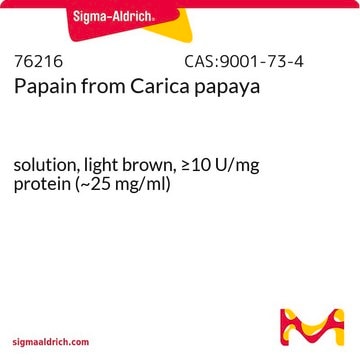91719
Trifluoroacetic anhydride
for GC derivatization, LiChropur™, ≥99.0% (GC)
Synonim(y):
TFAA
About This Item
Polecane produkty
klasa czystości
for GC derivatization
Poziom jakości
ciśnienie pary
6.28 psi ( 20 °C)
Próba
≥99.0% (GC)
Postać
liquid
jakość
LiChropur™
przydatność reakcji
reagent type: derivatization reagent
reaction type: Acylations
reagent type: derivatization reagent
reaction type: Esterifications
metody
gas chromatography (GC): suitable (ECD)
współczynnik refrakcji
n20/D 1.3 (lit.)
tw
39.5-40 °C (lit.)
mp
−65 °C (lit.)
gęstość
1.511 g/mL at 20 °C (lit.)
temp. przechowywania
2-8°C
ciąg SMILES
FC(F)(F)C(=O)OC(=O)C(F)(F)F
InChI
1S/C4F6O3/c5-3(6,7)1(11)13-2(12)4(8,9)10
Klucz InChI
QAEDZJGFFMLHHQ-UHFFFAOYSA-N
Szukasz podobnych produktów? Odwiedź Przewodnik dotyczący porównywania produktów
Powiązane kategorie
Zastosowanie
Inne uwagi
Informacje prawne
Hasło ostrzegawcze
Danger
Zwroty wskazujące rodzaj zagrożenia
Zwroty wskazujące środki ostrożności
Klasyfikacja zagrożeń
Acute Tox. 4 Inhalation - Aquatic Chronic 3 - Eye Dam. 1 - Skin Corr. 1A
Zagrożenia dodatkowe
Kod klasy składowania
8A - Combustible corrosive hazardous materials
Klasa zagrożenia wodnego (WGK)
WGK 2
Środki ochrony indywidualnej
Faceshields, Gloves, Goggles
Choose from one of the most recent versions:
Masz już ten produkt?
Dokumenty związane z niedawno zakupionymi produktami zostały zamieszczone w Bibliotece dokumentów.
Klienci oglądali również te produkty
Nasz zespół naukowców ma doświadczenie we wszystkich obszarach badań, w tym w naukach przyrodniczych, materiałoznawstwie, syntezie chemicznej, chromatografii, analityce i wielu innych dziedzinach.
Skontaktuj się z zespołem ds. pomocy technicznej











